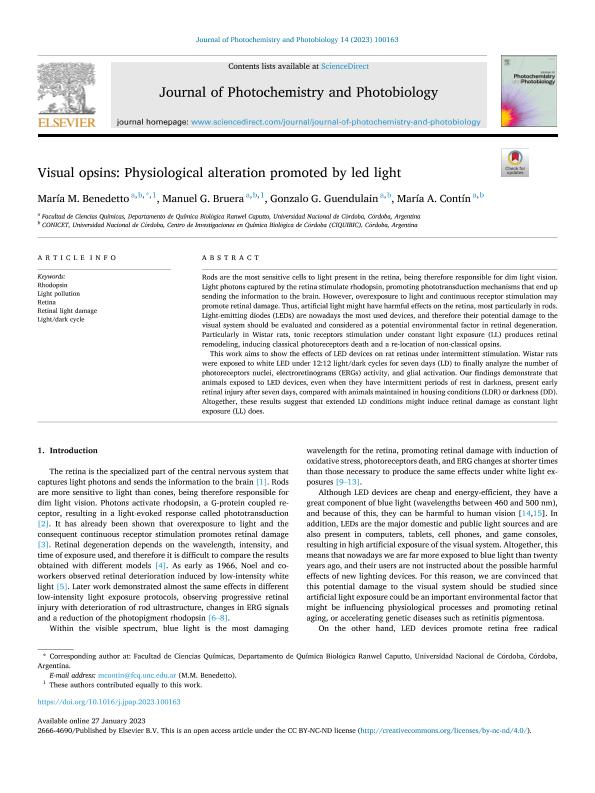Mostrar el registro sencillo del ítem
dc.contributor.author
Benedetto, Maria Mercedes

dc.contributor.author
Bruera, Manuel Gaston

dc.contributor.author
Guendulain, Gonzalo Germán

dc.contributor.author
Contin, Maria Ana

dc.date.available
2024-02-08T10:00:39Z
dc.date.issued
2023-04
dc.identifier.citation
Benedetto, Maria Mercedes; Bruera, Manuel Gaston; Guendulain, Gonzalo Germán; Contin, Maria Ana; Visual opsins: Physiological alteration promoted by led light; Elsevier; Journal of Photochemistry and Photobiology; 14; 4-2023; 1-6
dc.identifier.issn
2666-4690
dc.identifier.uri
http://hdl.handle.net/11336/226238
dc.description.abstract
Rods are the most sensitive cells to light present in the retina, being therefore responsible for dim light vision. Light photons captured by the retina stimulate rhodopsin, promoting phototransduction mechanisms that end up sending the information to the brain. However, overexposure to light and continuous receptor stimulation may promote retinal damage. Thus, artificial light might have harmful effects on the retina, most particularly in rods. Light‐emitting diodes (LEDs) are nowadays the most used devices, and therefore their potential damage to the visual system should be evaluated and considered as a potential environmental factor in retinal degeneration. Particularly in Wistar rats, tonic receptors stimulation under constant light exposure (LL) produces retinal remodeling, inducing classical photoreceptors death and a re-location of non-classical opsins. This work aims to show the effects of LED devices on rat retinas under intermittent stimulation. Wistar rats were exposed to white LED under 12:12 light/dark cycles for seven days (LD) to finally analyze the number of photoreceptors nuclei, electroretinograms (ERGs) activity, and glial activation. Our findings demonstrate that animals exposed to LED devices, even when they have intermittent periods of rest in darkness, present early retinal injury after seven days, compared with animals maintained in housing conditions (LDR) or darkness (DD). Altogether, these results suggest that extended LD conditions might induce retinal damage as constant light exposure (LL) does.
dc.format
application/pdf
dc.language.iso
eng
dc.publisher
Elsevier

dc.rights
info:eu-repo/semantics/openAccess
dc.rights.uri
https://creativecommons.org/licenses/by-nc-nd/2.5/ar/
dc.subject
LIGHT POLLUTION
dc.subject
LIGHT/DARK CYCLE
dc.subject
RETINA
dc.subject
RETINAL LIGHT DAMAGE
dc.subject
RHODOPSIN
dc.subject.classification
Otros Tópicos Biológicos

dc.subject.classification
Ciencias Biológicas

dc.subject.classification
CIENCIAS NATURALES Y EXACTAS

dc.title
Visual opsins: Physiological alteration promoted by led light
dc.type
info:eu-repo/semantics/article
dc.type
info:ar-repo/semantics/artículo
dc.type
info:eu-repo/semantics/publishedVersion
dc.date.updated
2024-02-06T13:58:30Z
dc.journal.volume
14
dc.journal.pagination
1-6
dc.journal.pais
Estados Unidos

dc.description.fil
Fil: Benedetto, Maria Mercedes. Consejo Nacional de Investigaciones Científicas y Técnicas. Centro Científico Tecnológico Conicet - Córdoba. Centro de Investigaciones en Química Biológica de Córdoba. Universidad Nacional de Córdoba. Facultad de Ciencias Químicas. Centro de Investigaciones en Química Biológica de Córdoba; Argentina
dc.description.fil
Fil: Bruera, Manuel Gaston. Consejo Nacional de Investigaciones Científicas y Técnicas. Centro Científico Tecnológico Conicet - Córdoba. Centro de Investigaciones en Química Biológica de Córdoba. Universidad Nacional de Córdoba. Facultad de Ciencias Químicas. Centro de Investigaciones en Química Biológica de Córdoba; Argentina
dc.description.fil
Fil: Guendulain, Gonzalo Germán. Consejo Nacional de Investigaciones Científicas y Técnicas. Centro Científico Tecnológico Conicet - Córdoba. Centro de Investigaciones en Química Biológica de Córdoba. Universidad Nacional de Córdoba. Facultad de Ciencias Químicas. Centro de Investigaciones en Química Biológica de Córdoba; Argentina
dc.description.fil
Fil: Contin, Maria Ana. Consejo Nacional de Investigaciones Científicas y Técnicas. Centro Científico Tecnológico Conicet - Córdoba. Centro de Investigaciones en Química Biológica de Córdoba. Universidad Nacional de Córdoba. Facultad de Ciencias Químicas. Centro de Investigaciones en Química Biológica de Córdoba; Argentina
dc.journal.title
Journal of Photochemistry and Photobiology
dc.relation.alternativeid
info:eu-repo/semantics/altIdentifier/url/https://www.sciencedirect.com/science/article/pii/S2666469023000040?via%3Dihub
dc.relation.alternativeid
info:eu-repo/semantics/altIdentifier/doi/http://dx.doi.org/10.1016/j.jpap.2023.100163
Archivos asociados
